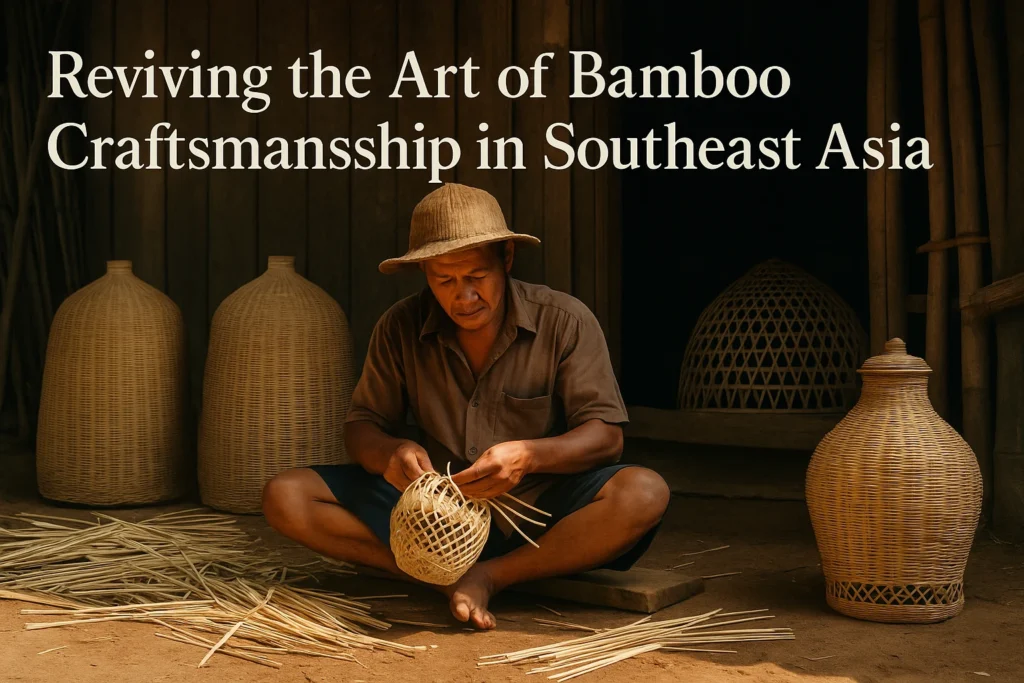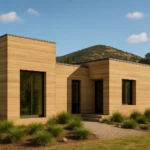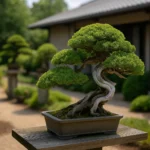The Whispering Forests: Where Bamboo Comes to Life
Imagine stepping into a world where the air is thick with the sweet, earthy scent of growth, and sunlight filters through a canopy of swaying green. This is the heart of Southeast Asia, a land sculpted by emerald hills and ancient rivers, where bamboo has always been more than just a plant – it has been the very essence of life itself. For countless generations, families have lived alongside these towering stalks, their hands learning to coax strength and beauty from nature’s bounty. From the sturdy framework of a cozy home that shelters generations to the intricate weave of a fishing trap that feeds a community, bamboo was meticulously shaped into tools, dwellings, and breathtaking works of art. Every cut, every bend, every woven strand whispered stories of tradition, resilience, and an unbreakable bond between people and their environment. It was a time when sustainability wasn’t a concept but an ingrained way of living, where resources were honored and utilized with profound respect.
However, as the winds of change blew in from the industrialized world, carrying with them the promises of convenience and modernity, the whispers of the bamboo forests began to soften, almost fading into silence. The allure of mass-produced plastic, cheap and readily available, alongside the perceived permanence of steel and concrete, slowly overshadowed the painstaking, time-honored techniques of bamboo craftsmanship. For a period, it seemed as though these intricate skills, once as common as breathing, might recede into the annals of history, becoming mere curiosities in museums rather than vibrant living traditions. But true artistry, much like nature itself, always finds a way to endure and flourish. Today, a profound and quiet revolution is unfolding across the diverse landscapes of Southeast Asia. From the mystical, mist-shrouded highlands of Vietnam, where ancient traditions cling to the mountain air, to the serene, life-giving riverbanks of Laos, a new generation of artisans, often guided by the wise hands of their elders, are passionately reclaiming their heritage. They are breathing vibrant new life into bamboo, transforming it into an astonishing array of creations – from elegant home décor that seamlessly blends into contemporary urban spaces to magnificent, soaring eco-friendly buildings that challenge the very definition of modern architecture. This isn’t simply a nostalgic look back at forgotten techniques; it’s a dynamic, forward-thinking movement. It’s a powerful blend of deep-seated cultural preservation, unwavering commitment to sustainability, and a bold embrace of modern design principles, proving unequivocally that the wisdom of the past can indeed illuminate the path to a greener, more conscious future for all.
Why Bamboo? The Green Gold of Southeast Asia
The designation “green gold” is no mere poetic flourish when applied to bamboo; it is a profound recognition of its extraordinary properties and its unparalleled role as a sustainable resource. Unlike the slow, deliberate growth of traditional hardwoods, which can take decades, even centuries, to reach maturity, some species of bamboo exhibit an almost miraculous growth rate, astounding botanists and environmentalists alike. It can grow an incredible three feet in a single day, a breathtaking pace that makes it one of the fastest-growing and most renewable resources on Earth. Imagine the implications: a material that replenishes itself at an astonishing speed, offering a continuous supply without depleting natural forests. But its rapid growth is just one facet of its remarkable character. When it comes to sheer strength, bamboo truly defies expectations. Pound for pound, it possesses a tensile strength that remarkably surpasses that of steel, making it an incredibly robust and durable material capable of bearing immense loads. Yet, for all its formidable strength, bamboo remains exceptionally lightweight and remarkably flexible – a unique combination of characteristics that renders it an ideal medium for crafting everything from the most delicate, intricate baskets to vast, imposing architectural marvels that stand testament to its structural integrity.
Beyond its impressive physical attributes, bamboo holds a deep, resonant cultural soul that is inextricably woven into the very fabric of Southeast Asian communities. It’s not just a plant; it’s a living legacy, a silent guardian of ancient wisdom and daily traditions. In the quiet, sun-drenched villages of Laos, one can still witness the timeless scene of elders patiently guiding the nimble fingers of children, teaching them the intricate art of splitting and weaving bamboo into ingenious fishing traps. This isn’t merely a transfer of skill; it’s an imparting of connection, a passing down of ancestral knowledge that links them directly to their heritage and their land. In the bustling workshops of Thailand, the meticulous hands of master artisans deftly steam and bend bamboo into gracefully curved, ergonomically designed furniture pieces, each elegant curve a testament to their profound understanding of the material’s properties and their own artistic mastery. And perhaps most inspiringly, on the idyllic island of Bali, a new wave of visionary architects are daring to push the very boundaries of what is possible. They are constructing entire bamboo pavilions and schools that seem to emerge organically from a fantastical, futuristic forest, their designs challenging conventional notions of construction, beauty, and harmony with nature. Bamboo, in this light, transcends its material form; it becomes a vibrant, living bridge, connecting the deep-seated wisdom of the past with the innovative possibilities of the present and the sustainable promises of the future. It truly is, in every sense, “green gold.”
From Villages to Global Markets: The Rise of Bamboo Craftsmanship
1. The Artisans Keeping Tradition Alive: Whispers of Generations
Deep within the secluded, verdant valleys that define the northern reaches of Thailand, where mist often cloaks the towering peaks and ancient spirits are said to reside, the rhythmic sounds of weaving continue to echo. Here, in these untouched havens, reside master artisans whose hands, gnarled and strong from years of dedicated practice, are living libraries of ancestral knowledge. They employ techniques that have been meticulously refined and passed down through countless generations, each knot and weave a testament to an unbroken lineage. Their fingers, almost a blur with their hypnotic speed and astonishing precision, transform humble strips of raw bamboo into breathtakingly intricate baskets that are both functional and artistic, into ambient lampshades that cast warm, inviting glows across homes, and even into delicate musical instruments whose ethereal melodies seem to carry the very essence of the forest. Each completed piece is far more than just an object; it is a profound repository of history, a tangible manifestation of collective cultural knowledge, and a deeply moving tribute to the enduring spirit of human craftsmanship and ingenuity.
Further east, as dusk descends upon the enchanting city of Luang Prabang in Laos, the vibrant night market awakens, bathed in the soft, golden luminescence of myriad handwoven bamboo lanterns. Each flickering light seems to possess a unique story, a gentle whisper of the artisan who painstakingly crafted it under the tropical sun. Recognizing the immense cultural significance and the burgeoning economic potential of these invaluable traditions, numerous non-governmental organizations (NGOs) and forward-thinking local cooperatives have stepped in. They are playing a pivotal and proactive role in empowering these remarkably gifted artisans, establishing vital connections that link them directly with global buyers and discerning international markets. This crucial bridge not only ensures fair wages for their tireless work and exceptional skill, providing a sustainable livelihood, but also acts as a robust safeguard, meticulously protecting the authenticity and integrity of these invaluable cultural treasures from the encroaching pressures of mass commercialization and erosion of traditional values.
2. Bamboo in Modern Design: Where Tradition Meets Innovation – A Symphony of Forms
The inherent versatility, astonishing strength, and natural, understated elegance of bamboo have unequivocally captured the imagination of designers and architects across the globe, sparking a passionate and burgeoning romance between this ancient, revered material and the sleek, innovative demands of contemporary aesthetics. On the idyllic island paradise of Bali, visionary design firms like Ibuku stand at the absolute forefront of this revolutionary movement. They are crafting awe-inspiring bamboo villas and resorts that are not merely structures but rather living sculptures, redefining the very notions of luxury, architectural possibility, and sustainable living. Their breathtaking creations serve as powerful and undeniable testaments to the fact that eco-friendly architecture can be not only profoundly responsible and environmentally conscious but also stunningly opulent, architecturally sophisticated, and breathtakingly innovative, challenging preconceptions at every turn.
Simultaneously, a new wave of pioneering Vietnamese designers are orchestrating a captivating fusion, seamlessly blending the deep-rooted wisdom of ancient bamboo weaving techniques with the clean lines, minimalist forms, and functional demands that define modern furniture design. The compelling result is a stunning and diverse collection of pieces that fit effortlessly and harmoniously into contemporary homes and offices, showcasing bamboo’s unparalleled adaptability, its timeless appeal, and its innate ability to elevate any space. Recognizing the immense and rapidly growing importance of this craft, leading universities in bustling Hanoi and dynamic Ho Chi Minh City have proactively established specialized academic courses and cutting-edge design programs specifically focused on bamboo craftsmanship, sustainable design, and innovative applications. This forward-thinking educational approach is absolutely crucial, ensuring that the intricate knowledge, the artistic spirit, and the technical mastery of bamboo work are not merely preserved as relics of the past but are actively cultivated, evolved, and championed by the next generation of talented creators, guaranteeing a vibrant future for this extraordinary material.
3. The Economic and Environmental Impact: A Dual Triumph
The resurgence of bamboo craftsmanship is profoundly more than just a heartwarming cultural revitalization; it represents a significant and truly sustainable lifeline for rural economies across the diverse and vibrant landscapes of Southeast Asia. By meticulously producing and thoughtfully selling their exquisitely handmade bamboo products, families residing in remote, often economically vulnerable communities are able to secure stable, sustainable incomes. This vital economic alternative provides a dignified and empowering path to livelihood, significantly reducing their reliance on potentially destructive and unsustainable practices such as rampant deforestation for timber or the often-harsh and exploitative realities of low-wage factory work in urban centers. It fosters a powerful sense of self-sufficiency, strengthens invaluable community bonds, and encourages local entrepreneurship, creating thriving micro-economies rooted in tradition and sustainability.
From a critical environmental perspective, bamboo emerges as an undeniable hero in the relentless global fight against rampant plastic waste and the pervasive, escalating challenges of climate change. Unlike petroleum-based synthetic materials, which stubbornly persist in landfills and pollute ecosystems for centuries, bamboo boasts a remarkable property: it biodegrades naturally and completely. It gracefully returns to the earth without leaving behind any toxic residue or harmful pollutants, completing its life cycle in harmony with nature. Its astonishingly rapid growth rate is also a powerful ecological asset; dense bamboo forests are renowned for their exceptional and unparalleled capacity to absorb significantly more carbon dioxide (CO2) from the atmosphere than most tree species, acting as highly efficient carbon sinks. This makes bamboo cultivation and the wide array of its derived products an immensely formidable and accessible tool in mitigating the devastating effects of climate change, combating air pollution, and promoting a healthier, more balanced planet for current and future generations. The economic and environmental benefits, therefore, are intertwined, creating a powerful, positive feedback loop that champions both human well-being and ecological health.
How You Can Support the Bamboo Movement: Be a Part of the Story
If the compelling narrative of bamboo’s resurgence has resonated deeply with you, there are tangible and impactful ways you can actively contribute to this remarkable sustainable renaissance and become a part of its unfolding story:
- Buy Handmade Bamboo Products: Make a conscious choice to seek out and support artisans, fair-trade cooperatives, and ethical businesses that are dedicated to selling authentic, meticulously handcrafted bamboo creations. Your purchase is more than just acquiring an item; it directly empowers local communities, provides dignified livelihoods, and ensures that precious traditional skills are not only preserved but continue to thrive and evolve. Look for transparency in sourcing and fair wage practices.
- Visit Bamboo Workshops and Learn the Craft: Many villages, cultural centers, and sustainable tourism initiatives across Thailand, Vietnam, and Laos offer immersive, hands-on workshops and weaving classes. These experiences provide a unique opportunity to not only learn a new, fascinating skill but also to connect intimately with the heart of the bamboo movement. You’ll gain a deeper appreciation for the artistry and dedication involved, and perhaps even discover a hidden talent yourself.
- Support Sustainable Architecture and Design: If you’re contemplating building a new home, undertaking a significant renovation, or engaging in a design project, explore bamboo as a truly renewable, aesthetically stunning, and structurally sound alternative to conventional building materials. Research architects and builders specializing in bamboo construction and advocate for its use in public and private projects. Your choice can inspire others and accelerate the adoption of sustainable building practices.
The Future of Bamboo: Rooted in the Past, Growing Toward Tomorrow
The inspiring revival of bamboo craftsmanship across Southeast Asia is far more than a simple resurgence of ancient techniques; it is, at its core, a profound and actionable blueprint for sustainable living in the 21st century and well beyond. By consciously embracing and championing this ancient, incredibly versatile craft, we are doing more than just appreciating beautiful objects or preserving cultural heritage. We are actively honoring the timeless wisdom of past generations, recognizing their deep, intuitive understanding of natural resources, their profound respect for the earth, and their ingenious ability to live in harmony with their environment. Simultaneously, we are laying the foundational groundwork for a greener, more equitable, and more harmonious future for all. It’s a powerful testament to the idea that true progress often lies in rediscovering and revaluing what has always been inherently good and sustainable.
As the world increasingly grapples with the escalating complexities of climate change, resource depletion, and the urgent need for truly eco-friendly solutions, the dedicated, skilled, and passionate bamboo artisans of Southeast Asia offer a powerful, poignant, and hopeful reminder. They show us, through their masterful hands and their enduring creations, that sometimes, the most innovative, effective, and beautiful answers are not found in complex technological advancements or futuristic laboratories, but rather in the simple, elegant, and time-tested solutions that have been patiently awaiting our rediscovery and re-embrace – deeply rooted in the earth, brimming with potential, and ready to grow vigorously toward a brighter, more sustainable tomorrow.




mde80p